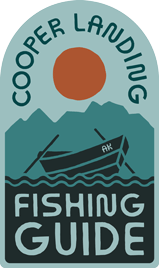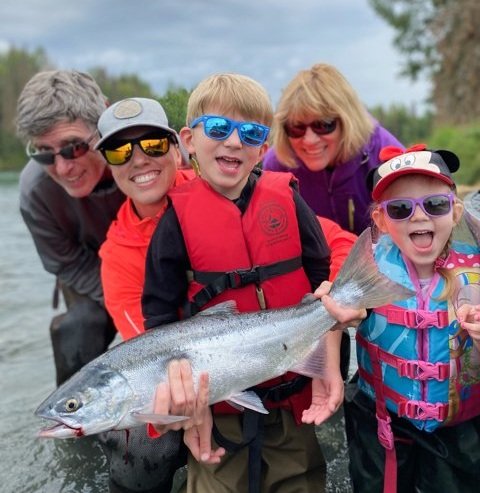Sockeye Salmon Fishing on the Kenai River
Arguably the hardest fighting and most prized salmon in Alaska, Sockeye or "Red" salmon, as they are commonly referred to, will put the most skilled anglers and the best rods & reels to the ultimate test.
Sockeye have an endless supply of energy and are known for their blistering speed, aerial displays and rod-bending power. Every year, they break at least one of my rods and I usually have to replace at least 1 or 2 reels.
A low rod angle will ensure you have complete control throughout a fight with a powerful Sockeye Salmon.
Averaging between 4-6 lbs., Sockeye return to the Kenai River in huge numbers. During typical summers, upwards of 1.5 million fish make their annual spawning run. Two distinct runs come up the Kenai River. The first run generally starts when the upper Kenai River opens on June 11th with about 40,000 fish making their way up the Kenai to the Russian River, a mountain tributary in Cooper Landing. This run lasts through early July.
The second, more prolific run of Sockeye Salmon arrives in mid-July and daily numbers of Sockeye entering the Kenai can reach upwards of 50,000 fish! The fish tend to spread out along the entirety of the Kenai and generally spreads out angling pressure.
A successful family outing on the Upper Kenai River during the first Sockeye Run in June.
Most successful angling for Sockeye Salmon occurs between June 11th and August 15th when fresh fish are still entering the system. The key to angling success and a full freezer is the proper gear, technique and expectations.
Sockeye Salmon are unique in that they primarily feed on plankton while in the ocean unlike their cousins that feed on fish, crustaceans, squid and other prey. Given this fact, it can be difficult to entice them to take spinners and flies that Coho and Kings are known to take.
The primary technique to hook a Sockeye is known as "flipping." Anglers "flip" a weighted system, relatively long leader and a sparse "Russian River Fly" or "Coho Fly" slightly upstream and carefully slide a weight along the bottom through pods of migrating fish. Most fish will successfully hook themselves as they swim up river in the corner of their mouths. This is when the fun really begins!
Sockeye are explosive and can literally rip the rod out of your hands if you're not careful. The absolute key to landing a fish is to keep your rod tip low and downstream. Most fish are hooked on the outside of their mouths away from you, so if you lift your rod or bring it upstream and the fish turns, there's a very good chance you'll lose it.
Be prepared for multiple, full-speed, powerful runs. The lower your rod angle, the more you'll be able to control the fish. Most of the time, you will not be able to tire Sockeye out, so you either have to have a very good net-minder or drag the fish ashore (that is if you plan on harvesting your fish). If you do not plan on harvesting Sockeye, do not beach them - their survival rate will suffer.
SUGGESTED EQUIPMENT:
8 or 9 wt FLY ROD
LARGE ARBOR FLY REEL WITH PLENTY OF BACKING AND POWERFUL DRAG SYSTEM
30 lb. LEADER
SNAP SWIVEL
BELL SINKERS (VARIOUS WEIGHTS)
25 lb. TIPPET
STRONG SALMON HOOK SIZE 2 OR 4 (CHECK REGULATIONS)




